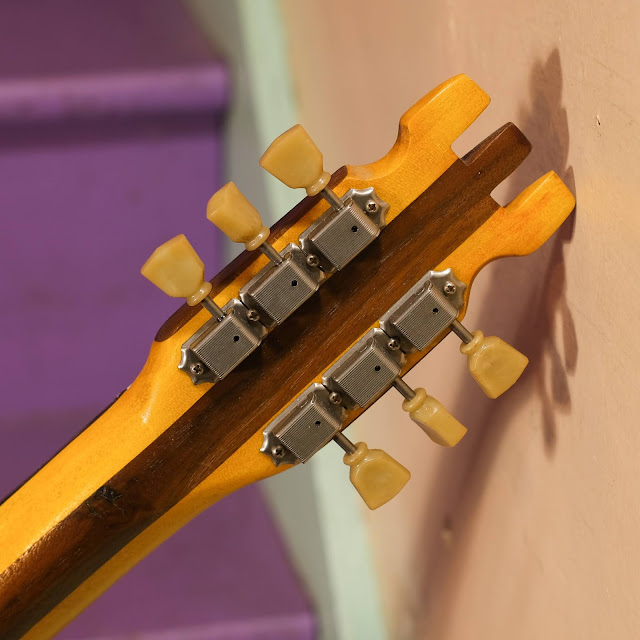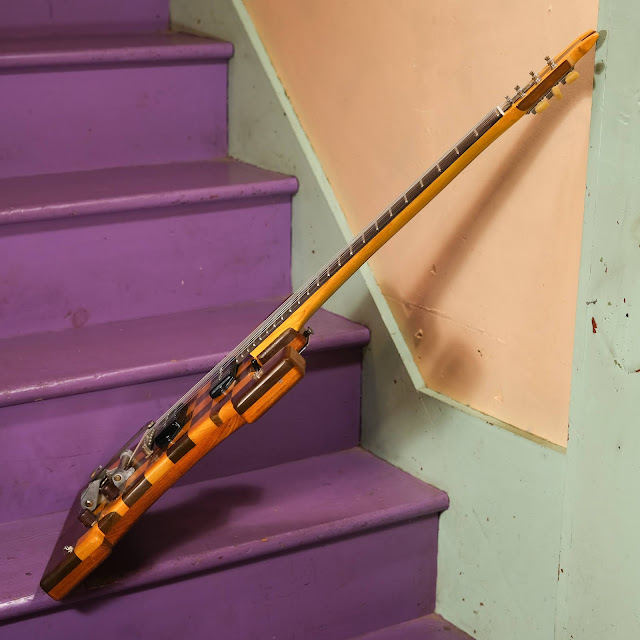2020 Todd's Chesscaster Electric Guitar
My friend Todd killed an inordinate amount of shop-time destroying my brain with this guitar. He was really hot to trot on the idea of making a solidbody electric of his own "from scratch." Sure thing, buddy! Of course, he wanted to make it out of his high school shop-class chess table. Ergh. This is where the troubles began as every decision of the design basically meant he was doing things the hard way.
The body is made from the chess table itself (soft maple and walnut) mated to a salvaged mahogany (or hog-family) back that we glued up to it. He then (of course) had me cut the dang thing into the shape of a rook (castle) instead of, ya know -- something practical and sensual to hold. Fortunately, he was the one who had to spend a frustrating amount of time fine-sanding that awkward shape.
Next-up, he made the neck from the turned, pedestal base for the table. Oh, damn. I warned him against this. I was fortunate there, though, because my buddy Dick helped him with the hair-raising challenge of cutting it down to serve as neck stock. After it got the "two sides flat" cut, we routed and fit a truss rod, glued the board up, and I helped him rough the neck to shape and then got to chuckle as he learned to get used to the painful process of finalizing a neck's cut.
I let him suffer the fretting process and helped him rout-out and cut all the body cavities and lay-out and pre-drill for the hardware. The tuners had to be clipped in the fashion of '50s Fender Klusons due to the small headstock shape. He didn't want a pickguard so everything had to be routed from the back more-or-less freehand and with small guides. Oh, joy.
I did the final wiring, pickup install, hardware install, and setup work. This took an absurdly-long time because, against my advice (folks: this advice comes with many years of pain in knowing what's involved with your crazy plans -- please listen), he wanted to stock a 3-way up in the Jazzmaster position and wanted to run a two-volume control layout. That means cramming three back-and-forth runs of shielded wire from the controls to the switch through long 1/8" holes drilled between cavities. I swore a lot... and... I mean, a lot. I might have kicked Todd out of the shop out of frustration had he been around for that.
Anyway, it turned-out nice. The neck's big and chunky and sports a short scale length (necessitated by its layout). It weighs about like a Les Paul and handles a bit like a '50s one, too. The Creamery P90 pickups have metal covers and sound very relaxed and fairly mellow. I like 'em. He opted for aged hardware throughout and the Bigsby was "relic'd" but as it sat-around waiting to be installed, the lightly-rusty bar actually froze-up and had to be cleaned-up with lube before use. Oh my.
Scale length: 24"
Nut width: 1 3/4"
String spacing at nut: 1 9/16"
String spacing at bridge: 1 15/16"
Body length: 17"
Lower bout width: 12 3/8"
Side depth at endpin: 1 3/8"
Body wood: mahogany, maple, walnut
Fretboard: rosewood
Bridge: Gotoh ABR-style, Bigsby B50 relic'd whammy
Neck feel: big C-shape, 12" board radius
Neck wood: maple/walnut
Weight: 9 lb 5 oz
















Comments